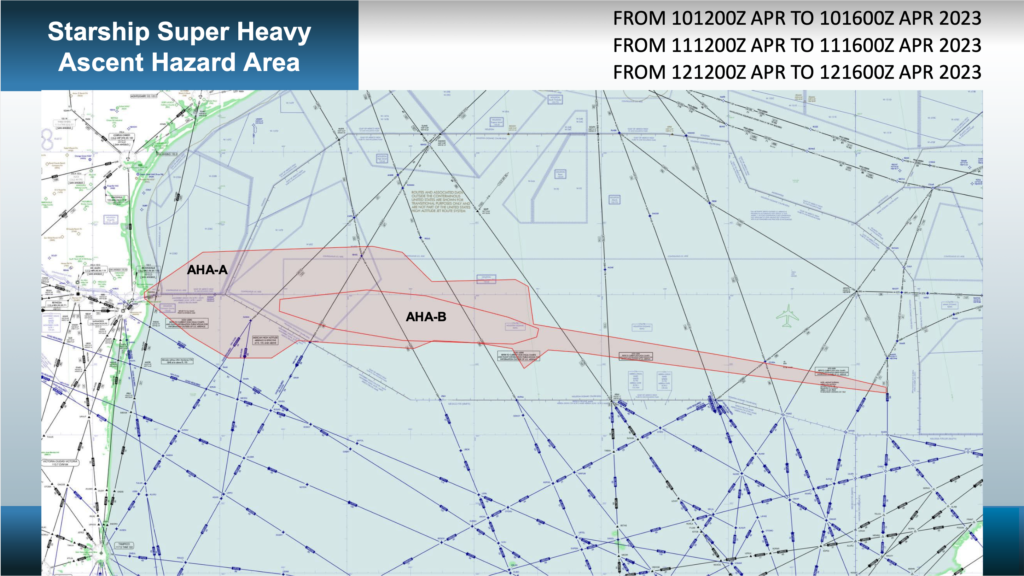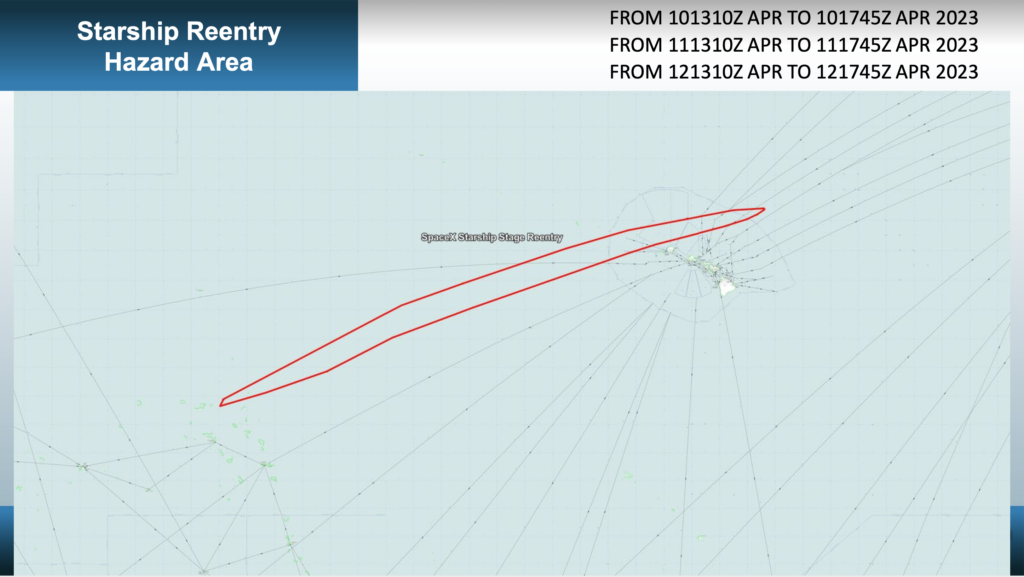**Update: April 12, 02:00z**
The launch has been delayed. It will now take place on April 17, with back up days on April 18 – 23. The new launch window will be from 12:00 – 15:05z each day.
——-
On April 10, SpaceX is planning on test launching a prototype re-useable superheavy rocket – Starship – from a launch facility in Southern Texas. The impact on the US NAS will be larger than most rocket launches due a reasonably high chance of failure of the ten million pound behemoth. Elon Musk himself has only given the launch a 50/50 shot of actually working. But he is ‘guaranteeing excitement’ either way.
The FAA are taking no chances, and on launch day several large hazard areas will be established for both liftoff, and subsequent reentry. This will impact coastal traffic over the Gulf of Mexico near the Texan coast, along with traffic in and out of Hawaii.
Let’s take a closer look.

Even Elon has only given the launch a fifty percent chance of working…
Launch
Liftoff will take place from a facility in Boca Chica, on the coast of Southern Texas.
The official launch date is April 10, with April 11 and 12 standing by as back ups. The action will take place between 12:00z and 16:00z (07:00 – 11:00am LT) each day.
In addition to a TFR extending 12nm off the coast from the launch site itself, for the ascent there will be two large hazard areas established well out into the Gulf of Mexico protected by Altitude Reservations.
 Several airways off the coast will be impacted – primarily for those running north and south between the mainland US and Southern Mexico. Major ones include L207, L208, A766, A770, L214, and L333 impacting boundary waypoints IPSEV, DUTNA, KEHLI, IRDOV and PISAD between the KZHU/Houston Oceanic and MMFR/Mexico FIRs.
Several airways off the coast will be impacted – primarily for those running north and south between the mainland US and Southern Mexico. Major ones include L207, L208, A766, A770, L214, and L333 impacting boundary waypoints IPSEV, DUTNA, KEHLI, IRDOV and PISAD between the KZHU/Houston Oceanic and MMFR/Mexico FIRs.
The good news for east/westbound traffic is that the hazard areas are fairly narrow, which means for the most part those published tracks will avoid the worst of the disruptions.
Additional congestion will be felt on alternative routes – especially for aircraft transiting to and from Florida’s airspace via waypoint CANOA, and inland of the Texan Coast.
Reentry
Because this is simply a test flight, the rocket will reenter again on the same day as the launch, this time affecting Hawaii.
The reentry window is set for 13:10 – 17:45z (03:10 – 07:45 LT), with a hazard area established in a line from just north of the island group, extending well west into the Pacific.
Three airways connecting to the mainland US will be affected – A331, R463, R464 with transitions via waypoints ZIGIE, APACK and BITTA. There is also a Guam-bound airway to the west that will be impacted – A450 via the transition BRIUN.
 Mission Accomplished
Mission Accomplished
Once the mission is complete, the airspace will be returned to the US NAS and we’ll be back to ops normal. Likewise if the mission is scrubbed, the airspace will be opened up again and the launch rolled over to back up days.
If you’re tired of space related disruptions, we feel you. In fact it is a growing issue now that we’re having to share the skies with competing interests. We wrote an article on that very issue, which you may find an interesting read.
For more on this upcoming launch, see the official FAA briefing here.
More on the topic:
- More: Cornish pasty with a side of Rocket
- More: Space. The Final Frontier.
- More: Go For Launch: Lift Off in California
- More: The POTUS TFR is a NO TO US
- More: Red Sky at Night, Aviator’s Fright
More reading:
- Latest: Teterboro: RIP the RUUDY SIX
- Latest: 400% increase in GPS Spoofing; Workgroup established
- Latest: GPS Spoofing WorkGroup 2024
- Safe Airspace: Risk Database
- Weekly Ops Bulletin: Subscribe
- Membership plans: Why join OPSGROUP?











 Get the famous weekly
Get the famous weekly 





